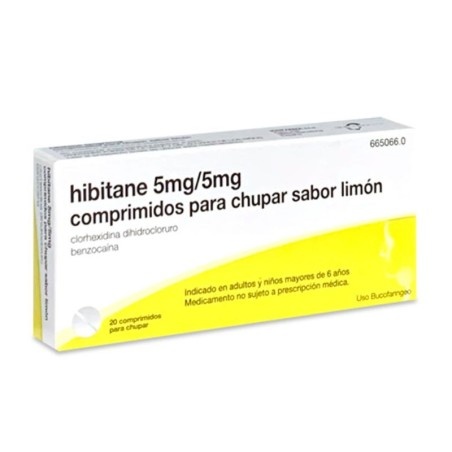

HIBITANE 5 mg/5 mg LOZENGES LEMON FLAVOURED

Ask a doctor about a prescription for HIBITANE 5 mg/5 mg LOZENGES LEMON FLAVOURED

How to use HIBITANE 5 mg/5 mg LOZENGES LEMON FLAVOURED
Introduction
Package Leaflet: Information for the User
HIBITANE 5mg/5mg Lemon-Flavored Lozenges
chlorhexidine dihydrochloride/benzocaine
Read all of this leaflet carefully before you start taking this medicinebecause it contains important information for you.
- Keep this leaflet, you may need to read it again.
- If you need advice or more information, ask your pharmacist.
- If you experience side effects, consult your doctor or pharmacist even if they are not listed in this leaflet. See section 4.
- You should consult your doctor if it worsens or does not improve after 2 days.
Contents of the package leaflet:
- What is Hibitane and what is it used for
- What you need to know before taking Hibitane
- How to take Hibitane
- Possible side effects
- Storage of Hibitane
- Contents of the pack and other information
1. What is Hibitane and what is it used for
The active ingredients of this medicine act by combining the antiseptic and disinfectant action of chlorhexidine with the local anesthetic action of benzocaine.
This medicine is used for the temporary relief of local symptoms of mild throat infections without fever, such as: sore throat, irritation, hoarseness.
2. What you need to know before taking Hibitane
Do not take Hibitane
- If you are allergic (hypersensitive) to chlorhexidine, benzocaine, or any of the other components of this medicine (listed in section 6).
Warnings and precautions
Consult your doctor or pharmacist before taking Hibitane:
- If you do not tolerate other local anesthetics like para-aminobenzoic acid (PABA), parabens, or paraphenylenediamine (a hair dye component).
- If you have any severe or extensive injury in the mouth.
- If you suffer from periodontitis (gum disease), because chlorhexidine may cause an increase in supragingival calculus.
- Do not take more than the recommended dose in section 3 (How to take Hibitane).
It is recommended to maintain good oral hygiene to reduce the accumulation of plaque and possible tooth discoloration that may be caused by chlorhexidine.
Other medicines and Hibitane
Tell your doctor or pharmacist if you are taking, have recently taken, or might take any other medicines.
Although not described in the recommended conditions of use, it should not be used with other mouth or throat application medicines without consulting your doctor or pharmacist.
Medicine interactions can be especially important with:
- Other mouth or throat antiseptics.
- Cholinesterase inhibitor medicines (medicines for Alzheimer's disease).
- Sulfonamides (used for infections).
Anionic compounds and suspending agents, common components of toothpastes, decrease the efficacy of chlorhexidine, so the mouth should be rinsed well after using toothpaste.
Interference with diagnostic tests
This medicine may interact with the pancreatic function test using bentiromide. Do not take this medicine at least three days before the test and inform your doctor.
Pregnancy and breastfeeding
Consult your doctor or pharmacist before taking any medicine.
Important for women
If you are pregnant, breastfeeding, think you may be pregnant, or plan to become pregnant, consult your doctor before taking this medicine.
Use in people over 65 years old
Older people and debilitated patients may be more sensitive to benzocaine.
Use in children
This medicine should not be given to children under 6 years old without consulting a doctor first.
Children may be more sensitive to benzocaine, just like the elderly and debilitated patients.
Driving and using machines
No cases have been reported that affect the ability to drive or operate machinery.
Hibitane contains:
- Sodium: this medicine contains less than 23 mg of sodium (1mmol) per lozenge, which is essentially "sodium-free".
- Sulfur dioxide (E-220): this medicine may cause severe allergic reactions and bronchospasm (sudden feeling of suffocation) because it contains sulfur dioxide (as part of the flavors).
- Sucrose: this medicine contains sucrose. If your doctor has told you that you have an intolerance to certain sugars, consult with them before taking this medicine.
- Butylhydroxyanisole (E-320): this medicine may cause local skin reactions (such as contact dermatitis) or eye and mucous membrane irritation because it contains butylhydroxyanisole.
This medicine contains fragrances with citral, citronellol, D-limonene, geraniol, and linalool.
Citral, citronellol, D-limonene, geraniol, and linalool may cause allergic reactions.
3. How to take Hibitane
Follow the administration instructions of the medicine contained in this leaflet or as indicated by your doctor or pharmacist. In case of doubt, ask your doctor or pharmacist.
If you think the action of Hibitane is too strong or too weak, tell your doctor or pharmacist.
This medicine is for buccopharyngeal use, so the lozenges should be dissolved slowly in the mouth without chewing or swallowing, as its action is local and only occurs when the product is in direct contact with the affected area.
The normal dose is as follows:
Adults and children over 6 years old:
1 lozenge every 2 or 3 hours, dissolving it slowly in the mouth.
Do not take more than 8 lozenges in 24 hours (1 day).
Dissolve the lozenge slowly in the mouth without chewing or swallowing.
Always use the smallest effective dose.
If you notice that the symptoms worsen or persist for more than 2 days after starting treatment, or if fever, headache, nausea, or vomiting appear, you should consult your doctor as soon as possible.
If you take more Hibitane than you should:
If you have taken more than you should, consult your doctor, pharmacist, or call the Toxicology Information Service, phone 915 62 04 20, indicating the medicine and the amount taken.
The main symptoms of overdose are: slurred speech, numbness, staggering gait, blurred or double vision, dizziness, excitement or convulsions, ringing in the ears, increased sweating. A decrease in blood pressure may also occur.
4. Possible side effects
Like all medicines, this medicine can cause side effects, although not everybody gets them.
During the period of use of medicines with chlorhexidine and benzocaine, the following side effects have been observed, whose frequency cannot be established with precision.
Tooth discoloration may appear. This staining or discoloration may be more pronounced in people with plaque on their teeth. This alteration of tooth color is not permanent and can be removed by a dental cleaning. The color of fillings may also be altered, in which case this discoloration may be permanent.
Alteration in taste perception may appear.
In some cases, this medicine may cause irritation in the mouth or irritation of the tip of the tongue, which are usually transient, as well as allergic reactions to chlorhexidine or benzocaine.
Reporting of side effects
If you experience any side effects, consult your doctor or pharmacist, even if they are not listed in this leaflet. You can also report them directly through the Spanish Medicines and Healthcare Products Agency (AEMPS) website: https://www.notificaram.es. By reporting side effects, you can help provide more information on the safety of this medicine.
5. Storage of Hibitane
Keep this medicine out of the sight and reach of children.
Do not store above 25°C.
Do not use this medicine after the expiration date stated on the packaging after CAD. The expiration date is the last day of the month indicated.
Medicines should not be disposed of via wastewater or household waste. Place the packaging and any unused medicines in the SIGRE collection point at your pharmacy. If in doubt, ask your pharmacist how to dispose of the packaging and any unused medicines. This will help protect the environment.
6. Additional information
Composition of Hibitane
Each lozenge contains:
- As active ingredients: Chlorhexidine dihydrochloride 5 mg and benzocaine 5 mg.
- The other components (excipients) are: mannitol (E-421), microcrystalline cellulose (E-460), povidone, magnesium stearate, sodium cyclamate, sodium saccharin (E-954), peppermint flavor (contains citronellol, D-limonene, sodium, and sulfur dioxide (E-220)), and lemon-lime flavor (contains citral, citronellol, D-limonene, geraniol, linalool, sodium, sulfur dioxide (E-220), sucrose, and butylhydroxyanisole (E-320)).
Appearance of the product and pack contents
They are lemon-flavored lozenges. This medicine is presented in packs of 20 lozenges.
Marketing authorization holder and manufacturer:
Holder:
IONFARMA s.l.u.
Perú, 228
08020 Barcelona, Spain
Manufacturer
Laboratorios Alcalá-Farma, S.L.
Avenida de Madrid, 82
28802 Alcalá de Henares
Madrid, Spain
Date of the last revision of this leaflet:September 2021
Detailed and updated information on this medicine is available on the website of the Spanish Agency for Medicines and Healthcare Products (AEMPS) http://www.aemps.es
- Country of registration
- Prescription requiredNo
- Manufacturer
- This information is for reference only and does not constitute medical advice. Always consult a licensed doctor before taking any medication. Oladoctor is not responsible for medical decisions based on this content.
- Alternatives to HIBITANE 5 mg/5 mg LOZENGES LEMON FLAVOUREDDosage form: TOPICAL ORAL PRODUCT, 10 mg/mlActive substance: povidone-iodineManufacturer: Cooper Consumer Health B.V.Prescription not requiredDosage form: GEL/PASTE/ORAL LIQUID, 10% povidone iodineActive substance: povidone-iodineManufacturer: Cooper Consumer Health B.V.Prescription not requiredDosage form: BUCCAL TABLET/LOZENGE, 2mg lidocaine/0.6mg amylmetacresol/1.2mg diclofenac alcoholActive substance: variousManufacturer: Laboratorios Cinfa S.A.Prescription not required
Alternatives to HIBITANE 5 mg/5 mg LOZENGES LEMON FLAVOURED in other countries
The best alternatives with the same active ingredient and therapeutic effect.
Alternative to HIBITANE 5 mg/5 mg LOZENGES LEMON FLAVOURED in Poland
Alternative to HIBITANE 5 mg/5 mg LOZENGES LEMON FLAVOURED in Ukraine
Online doctors for HIBITANE 5 mg/5 mg LOZENGES LEMON FLAVOURED
Discuss dosage, side effects, interactions, contraindications, and prescription renewal for HIBITANE 5 mg/5 mg LOZENGES LEMON FLAVOURED – subject to medical assessment and local rules.














